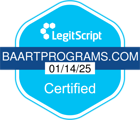Methadone is a synthetic opioid agonist whose effects are fully felt in a way that is very similar to morphine. Since it is manufactured in a lab, rather than being made from opium, it is not classified as a true opiate. As a part of a multi-faceted treatment program for opioid addiction, methadone can help reduce both the cravings and the withdrawal symptoms that occur when participating in an opioid abuse treatment program. Methadone has a long half-life meaning that it is effective in reducing withdrawal symptoms for much longer than many other opioids, up to 24-36 hours in most cases. When a therapeutic dose of methadone is taken under medical supervision, its long acting effects are helpful in combating the physical need for opiates, without causing euphoria or a “high”.
Methadone, when used for opioid addiction treatment, is administered at the treatment facility daily early in the patient’s recovery. Over time, patients can earn the privilege of taking medication home to limit the number of visits they have to make to the treatment program. Take homes are earned by complying with both the program’s guidelines and the federal guidelines in place, including participation in counseling services. BAART offers individual and group counseling to help patients deal with both the causes and consequences of addiction. The structure of a methadone maintenance program helps patients early in recover
First developed in the mid-1900’s, methadone’s initial development was as a drug that could replace the highly addictive drug, morphine. Available in the United States beginning in 1947, its primary use was for pain relief. It wasn’t until the 60’s and early 70’s, that its value as a treatment for narcotic addiction was realized. In 2001, the federal government improved regulations for the dispensing of methadone in a safe, controlled manner, allowing methadone to become the gold standard in Medication- Assisted Treatment (MAT) programs.y, and ensures that methadone is not misused during treatment.
Although available in a variety of formats, currently there are two FDA approved methadone products used for treating opioid dependency:
- Dolophine (methadone hydrochloride) tablets
- Methadose (methadone hydrochloride) oral concentrate
While useful as a part of a treatment regimen, methadone is not without possible side effects, not the least of which is the potential for methadone addiction. Other less serious complications that can occur in the short term, are:
- Nausea
- Itchiness
- Sweating vomiting
- Restlessness
Other drugs have been developed for the treatment of opioid addiction, such as buprenorphine or Suboxone® which, like methadone, reduces cravings for opiates. Buprenorphine is a partial agonist which doesn’t fully activate the receptors in the brain the way that methadone does, but it’s craving and withdrawal control are similar. When combined with naloxone in the brand name medication Suboxone® it can also cause immediate withdrawals if misused or injected, making it a great deterrent.
In addition to these medication, the drug Naltrexone® is sometimes used to treat opioid addiction. Unlike methadone and buprenorphine, naltrexone does not release any dopamine or cause any feelings of euphoria, but rather blocks the effects of any opioid taken which it’s in use. A patient must be fully abstinent of opioids for a period of 7-14 days before use of naltrexone.
As your journey out of opioid addiction progresses, you may find that your craving for opiates have been replaced by a dependence on methadone to provide symptom control. Because of the potential for addiction, working closely with your counselors and medical providers is critical to monitoring your progress and success. Once you have escaped the hold of opiates, your support team will then be able to begin the controlled process of slowly weaning you away from the need for methadone until finally, you will no longer need medication at all.
When combined with counseling and support, methadone is a safe, effective tool in the struggle to overcome opioid addiction. Reach out to one of the BAART Program facilities today for help in your battle with addiction.



